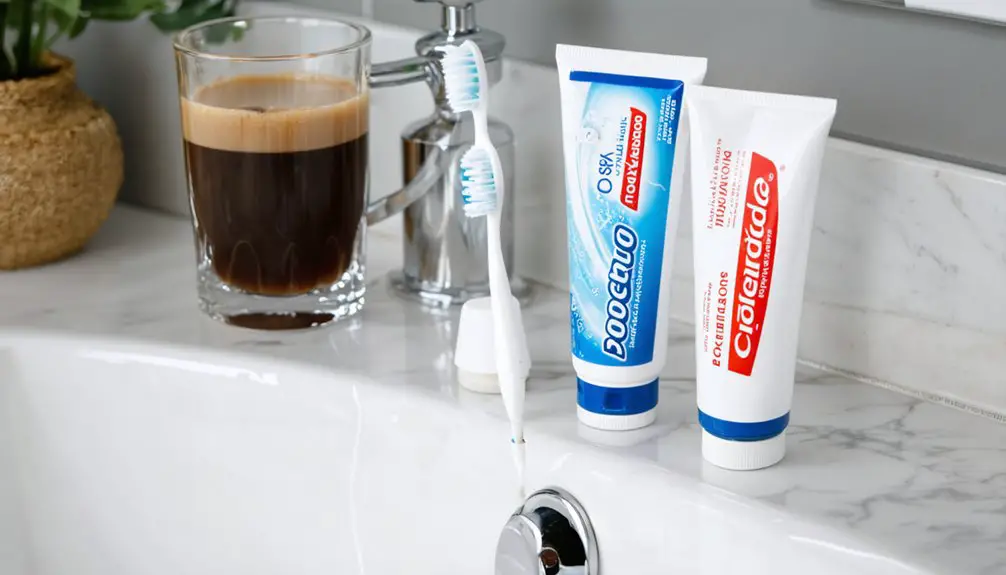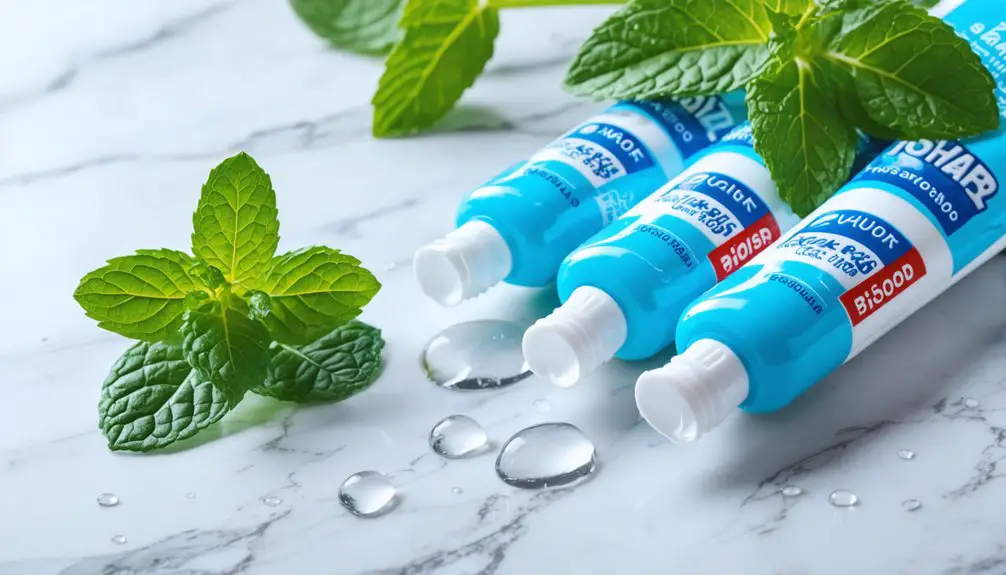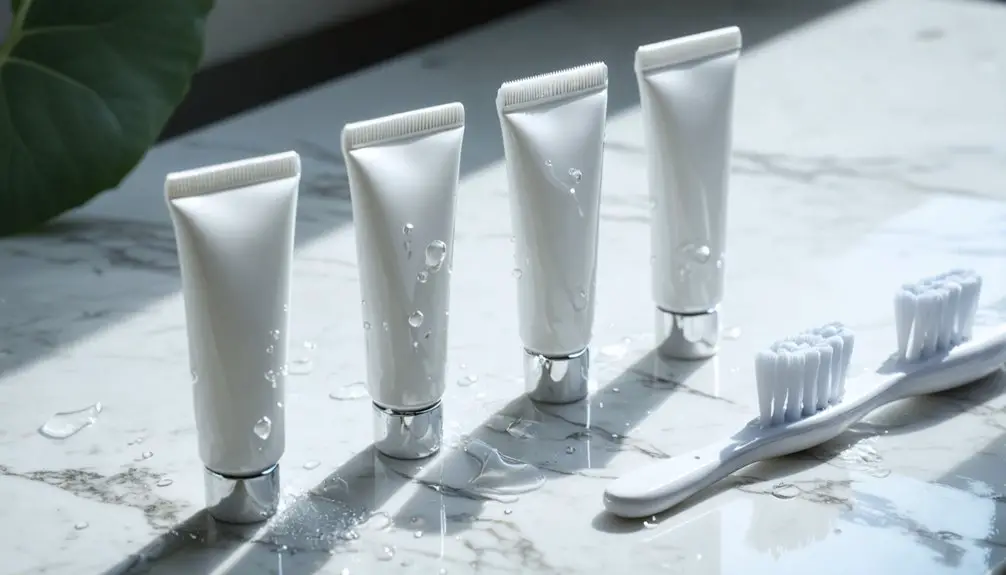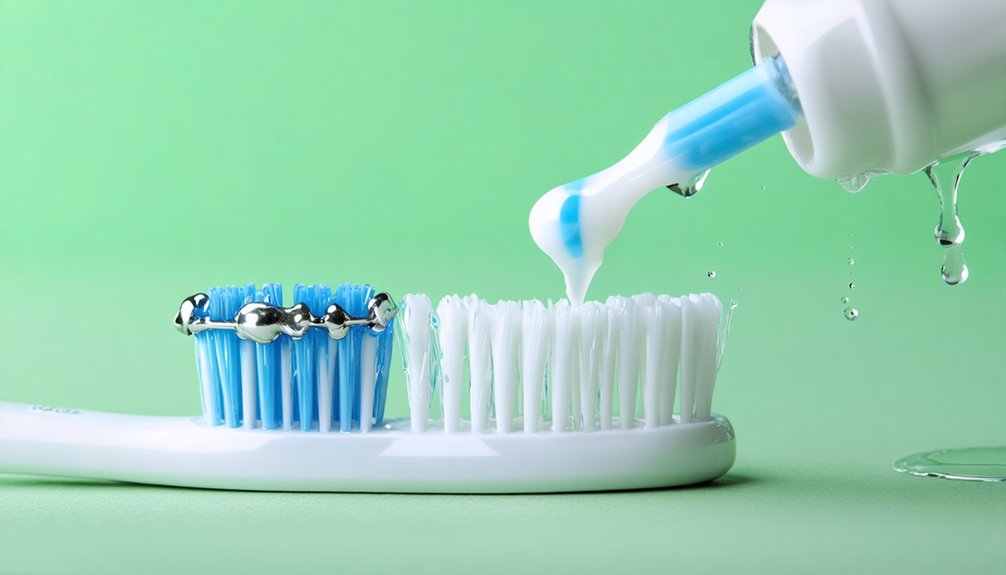To remove coffee stains, you’ll want a toothpaste containing hydrogen peroxide or carbamide peroxide as active whitening agents. These ingredients effectively break down surface stains through oxidation. Products like Colgate Optic White and Crest 3D White Brilliance can remove up to 95% of coffee stains within three days. For sensitive teeth, choose formulations with potassium nitrate. Understanding the right ingredients and techniques will maximize your stain-fighting results.
Key Takeaways
- Colgate Optic White and Arm & Hammer Advanced Whitening contain hydrogen peroxide and baking soda for effective coffee stain removal.
- Toothpastes with 35% hydrogen peroxide concentration demonstrate significant whitening effects on coffee-stained teeth.
- Colgate Luminous White Coffee Lovers is specifically formulated with targeted whitening agents for coffee drinkers.
- Crest 3D White Brilliance removes up to 95% of surface stains, including coffee stains, within three days.
- Toothpastes containing mild abrasives like baking soda and silica effectively polish away coffee stains without damaging enamel.
Best Toothpaste Ingredients for Coffee Stain Removal
When choosing a toothpaste for coffee stain removal, understanding the key active ingredients is essential for best results.
The most effective whitening agents include hydrogen peroxide and carbamide peroxide, which chemically break down stains through oxidation. These ingredients are clinically proven to target discoloration from coffee, tea, and wine while maintaining enamel protection. Products like Colgate Luminous White Coffee Lovers contain hydrogen peroxide whitening specifically designed for coffee drinkers. Regular use over time delivers optimal results since consistent brushing is necessary for effective stain reduction.
For gentle mechanical stain removal, look for formulations containing mild abrasives like baking soda and silica. These ingredients effectively polish away surface stains without damaging your tooth structure.
Additionally, sodium monofluorophosphate provides vital enamel protection during the whitening process.
While activated charcoal has gained popularity, it lacks strong clinical evidence compared to peroxide-based whitening agents and should be used with caution to prevent potential enamel damage.
Types of Whitening Toothpaste and Their Effectiveness
As consumers navigate the growing market of whitening toothpaste options, three distinct categories have emerged to address different oral care needs.
Commercial brands with peroxide-based whitening agents offer rapid stain removal, while sensitive formulations provide gentler whitening through specialized ingredients like potassium nitrate. Natural and fluoride-free options utilize alternative whitening agents such as silica and charcoal. Consistent twice daily brushing is essential for achieving optimal whitening results. Professional dental specialists recommend selecting toothpaste with stannous fluoride for added cavity protection.
Modern whitening toothpastes offer diverse solutions, from powerful peroxide formulas to gentle sensitive options and natural alternatives using charcoal and silica.
- Crest 3D White Brilliance removes up to 95% of surface stains within three days
- Sensodyne products balance whitening with sensitivity protection
- Natural formulations often require longer-term use for visible results
- Hydrogen peroxide and carbamide peroxide provide deep stain removal
- Silica and baking soda work as gentle physical stain removers
Each category’s effectiveness depends on its active ingredients’ concentration and your specific dental needs.
Understanding these differences helps you choose the most suitable option for coffee stain removal.
Safe Usage Guidelines for Stain-Fighting Toothpastes
Using whitening toothpaste effectively requires understanding proper application methods and safety protocols. To protect your enamel, brush with gentle, circular motions using a soft-bristled toothbrush and minimal pressure. Limit whitening toothpaste use to once or twice weekly to prevent tooth sensitivity and enamel erosion. For optimal results and safety, choose products containing potassium nitrate for sensitivity. Daily use of whitening toothpaste can increase tooth sensitivity and damage enamel.
Choose ADA Seal-approved products with RDA values below 250 for safe stain removal. If you’re experiencing sensitivity, consider switching to toothpaste containing nano-hydroxyapatite, which remineralizes enamel while fighting stains.
Monitor your teeth’s condition regularly and adjust usage based on your diet and oral health needs. Remember that proper technique matters more than frequency – excessive force during brushing can damage enamel even with safe toothpaste.
When in doubt, consult your dentist for personalized guidance on stain-fighting products.
Natural Methods to Enhance Toothpaste Whitening Power
Natural ingredients can greatly enhance your toothpaste’s whitening capabilities while providing additional oral health benefits. By incorporating natural abrasives and enzymatic agents alongside your regular toothpaste, you’ll boost its stain-fighting power.
Enhance your dental care naturally by adding whitening ingredients to your toothpaste, creating a powerful combination for a brighter, healthier smile.
- Baking soda neutralizes mouth acids and gently removes surface stains when mixed with toothpaste.
- Activated charcoal’s porous structure adsorbs stains and toxins, though use it cautiously due to abrasiveness.
- Cinnamon and peppermint enzymes contribute to stain reduction while freshening breath. Menthol compounds in peppermint provide powerful antibacterial effects for deeper cleaning.
- Aloe vera reduces harmful bacteria that cause staining and promotes gum health.
- Turmeric paste, despite its color, offers antioxidant effects that fight plaque buildup.
Regular brushing with these natural ingredients for at least twice daily ensures optimal whitening results over time.
For best results, combine these natural ingredients with your regular fluoride toothpaste to maintain enamel protection while targeting coffee stains.
Always dilute acidic ingredients and use abrasives sparingly to protect tooth enamel.
Expert-Recommended Products and Daily Care Tips
When selecting toothpaste for coffee stains, dental experts recommend products containing specific active ingredients proven to combat discoloration.
Leading toothpaste brands like Colgate® Optic White® and Arm & Hammer Advanced Whitening contain powerful combinations of hydrogen peroxide and baking soda for effective stain removal. Research shows that toothpastes containing 35% hydrogen peroxide demonstrate significant whitening effects.
For ideal results, you’ll want to brush twice daily using a soft-bristled toothbrush. Using whitening strips after brushing can provide additional stain-fighting benefits.
Apply gentle pressure to protect your enamel while effectively removing surface stains. After drinking coffee, rinse your mouth or brush your teeth promptly to minimize stain adherence.
Consider drinking water alongside your coffee to dilute stain-causing tannins.
Complement your daily care routine with regular dental cleanings and consult your dentist for personalized recommendations based on your specific staining patterns and oral health needs.
Frequently Asked Questions
How Long Do Coffee Stains Take to Form on Teeth?
You’ll notice coffee stains forming on your tooth enamel within minutes of drinking, though visible discoloration takes days to weeks of regular consumption before stain removal becomes necessary.
Can Drinking Coffee Through a Straw Prevent Tooth Staining?
Like a shield against arrows, drinking coffee through a straw offers partial staining prevention. While it’ll reduce contact with front teeth, you’ll still need proper dental care for complete protection.
Does Cold Brew Coffee Stain Teeth Less Than Regular Coffee?
While cold brew benefits include lower acidity, you’ll still experience tooth staining. There’s limited research comparing staining intensity between brewing methods, though both contain stain-causing tannins and pigments.
Are Coffee Stains Permanent if Left Untreated for Several Years?
While you might think years of neglect make coffee stains permanent, they’re not. You’ll need professional dental treatments for deeper stains, but proper stain removal and dental hygiene can still restore your smile.
Does Adding Milk or Cream to Coffee Reduce Its Staining Effects?
Yes, milk benefits include binding to coffee’s staining compounds through proteins, while cream effects help reduce stain adherence by creating a protective barrier and diluting pigment concentration on your teeth.
References
- https://kindfamilydentistry.com/5-easy-ways-to-get-rid-of-coffee-stains-on-your-teeth/
- https://www.emmydental.net/ways-to-remove-coffee-stains-from-your-teeth/
- https://pubmed.ncbi.nlm.nih.gov/38614882/
- https://www.wickerparkdentalgroup.com/ways-to-remove-coffee-stains-from-your-teeth/
- https://www.jkdhs.org/journal/view.html?uid=1174&vmd=Full
- https://pampadirect.com/colgate-luminous-white-coffee-lovers-cafe-toothpaste-coffee-stain-removal-whitening-formula-70-g-2-5-oz/
- https://www.huffmanfamilydentistry.com/best-whitening-toothpaste-for-coffee-drinkers/
- https://whiteglo.com/products/coffee-tea-toothpaste-150g
- https://myrobstowndentistry.com/choosing-the-best-toothpaste-for-whitening-your-teeth/
- https://mannfamilydental.com/blogs/unlock-your-brightest-smile-the-5-best-whitening-toothpastes-recommended-by-dentists/



